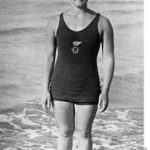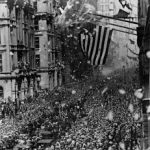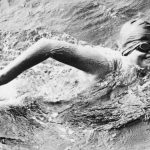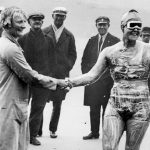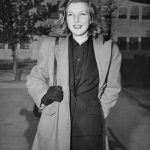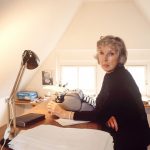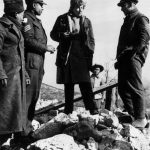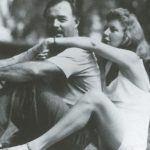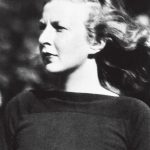Name: Gertrude Ederle
Birth: October 23, 1905 Death: November 30, 2003
- Lillian Cannon, Famous American swimmer in training at Cape Gris-Nez for an attempt to swim the English Channel, wishes Gertrude Ederle good luck before Ederle starts her swim. (Daily News photo)
What she did: First Women to Swim the English Channel
- Gertrude was born in New York City, NY on October 23 rd , 1905 to German immigrants as the third of 6 children.
- Her father, Henry taught her to swim in New Jersey where the family had a summer cottage.
- When they returned to New York City in the winter, Gertrude kept practicing, swimming in horse troughs.
The Amateur Hour
- Well Gertrude took to swimming like a fish to water and she began to train with the Women’s Swimming Association (WSA).
- Beginning at 12-years-old, Gertrude trained at the WSA’s small indoor pool for $3 a year (about $85 in today’s money) Though the pool was small, the WSA is known for training competitors including Ethelda Bleibtrey, Charlotte Boyle, Helen Wainwright, Aileen Riggin, Elanor Holm, and Esther Williams.
- The WSA was kind of a big deal at the time. The ‘front crawl’ or freestyle stroke was actually developed there.
- At the time, swimsuits for women were undergoing a revolution, evolving from the full-body dresses of yore to the more traditional style we know today. Still super conservative and included stockings, but a significant improvement from a drowning-inducing-frock. This made swimming more accessible (AKA possible) for women and competitive swimming saw a surge in popularity.
- The Amateur Athletic Union (AAU) was being pressured to recognize women’s swimming as a legitimate sport. In 1919, WSA director, Charlotte “Eppy” Epstein asked the AAU to “allow swimmers to remove their stockings for competition as long as they quickly put on a robe once they got out of the water.”
- Famous swim coach L.B. Handley volunteered at the WSA. He was also one of Gertrude’s early coaches. He’s known for developing new and more efficient swimming techniques including the ‘American front crawl’ which involved taking fewer breaths, thus leading to less resistance.
- Stockings or no, Gertrude became such a skilled swimmer she would have certainly been burned as a witch in years past.
- The same year she joined the WSA, Gertrude set her first world record in the 880 yard freestyle, making her the youngest world record holder in swimming.
- Gertrude first realized her skill in long-distance, open water swimming in 1922 when she was only 15-years-old. Gertrude entered the Joseph P. Day Cup, a 3 ½ mile race in New York Bay.
- Before this race, her longest race had only been 220 yards.
- She blew everyone’s bloomers off by beating U.S. champion Helen Wainwright and British champ Hilda James, along with 51 other contestants. I couldn’t find what she placed overall though.
- Gertrude continued leaving everyone in her wake as she set 8 more world records, 7 of which were in ONE YEAR.
- From 1921-1925, Gertrude held 29 national and world records.
- In 1924, Gertrude swam in the Summer Olympics in Paris.
- There she won a gold medal as part of the 4×100 meter freestyle relay. Her
and her team, comprised of Euphrasia Donnelly, Ethel Lackie, and Mariechen Wehselau, set a new world record of 4:58.8. - During the 1924 Summer Olympics, Gertrude also earned two bronze medals in the 100 meter and 400 meter freestyle.
- That year the American team brought home 99 medals and was met with a ticker-tape parade when they returned home.
- Gertrude would later say that “her failure to win three golds in the games was the biggest disappointment of her career.”
Professional Time
- Now, with 3 Olympic medals and dozens of world records under her swim cap, Gertrude was ready to go pro.
- In 1925 Gertrude swam 22 miles from Battery Park to Sandy Hook which took her 7 hours and 11 minutes, a record that would stand for 81 years. However, this was just, as her nephew described a “midnight frolic” and “warm-up” for her crowning moment.
- The English Channel is a body of water that separates Southern England from Northern France. It varies in width, but most swimmers start at the Straight of Dover which is about 20 miles wide (or if you’re
99% of the world, 33 km.) - Many people had attempted the swim, but only 5 had completed it by this
time. According to Dover.uk.com, 10 people have died while trying to complete the swim (starting in 1926.) - Creepy side note, while I was reading about the recorded deaths, at least 3 of people were only a few miles away from the coast when they died.
- Endurance-swimming was really hip at the time and Gertrude was ready for a new challenge. Originally, Gertrude was going to swim with another WSA swimmer, Helen Wainwright, but she had to back out at the last minute due to an injury.
- Gertrude decided to continue, alone. She trained with swimmer Jabez Wolffe who had attempted the Channel swim 22 times. Wolffe was also kinda sexist and commented that women may not be capable of making the swim.
- During trainings, Wolffe kept telling Gertrude to slow the fuck down because she would never make it at her quick pace.
- Apparently, learning from a 22-time failure didn’t work out, because when Gertrude made her first attempt, Wolffe got her disqualified by telling another swimmer to pull her out of the water.
- Wolffe thought she was drowning, but she was actually resting and Gertrude was pissed. It has understandably been speculated that the bitter, sexist, 22-time failure sabotaged Gertrude.
- Well, Gertrude began training with Bill Burgess, a swimmer who had successfully completed the Channel swim in 1911.
- At this time, Gertrude’s peers were attempting the swim themselves. 3 days before Gertrude attempted the Channel again, Clarabelle Barret made an attempt but got lost in some fog and was officially declared missing. She was found, but had to quit only 2 miles from the finish.
- One year later, on August 6 th , 1926, Gertrude set out from Cape Gris-Nez in France at 7:08 a.m.
- She was coated in olive oil, lanolin, and Vaseline in an attempt to help keep her warm. She also wore a two piece swimsuit, which is still a controversial move for competitive swimmers today.
- During her swim in the bitterly cold water, she encountered squalls which left Burgess urging her to get out of the water.
- Gertrude was like, fuck that, and kept going. Her father and sister were riding in the boat with Burgess and were also like fuck that and urged Gertrude to go on.
- Apparently, Gertrude’s father had promised to buy her a new roadster if she finished and during her swim, he would call out to remind her and motivate her.
- To protect her eyes from the salty water, Gertrude used motorcycle goggles that were sealed with paraffin to keep them water-tight.
- 14 hours and 31 minutes later, 20-year-old Gertrude completed her 35 mile swim at Kingsdown Kent.
- This made her the 6 th person ever to complete the swim and the 1 st woman to do so! Not only that, she beat the previous record by 2 hours!
- However, the long exposure to the cold water left Gertrude with hearing loss. I also read that she already had bad hearing due to measles as a kid, but either way the cold water didn’t help.
- Gertrude’s father had bet Lloyd’s of London that his daughter would succeed and subsequently won $175,000 (Almost 2.5 million in today’s money.)
- A butcher by trade, Gertrude’s father gave out free frankfurters to his whole neighborhood to celebrate.
- When Gertrude returned to Manhattan, she received a ticker-tape parade attended by some 2 million people.
- Gertrude was bombarded with book and movie deals along with marriage proposals. She toured North America, was in a movie, met President Coolidge, had a vaudeville career and more but all of this took its toll and she suffered a nervous breakdown in 1928.
- In 1933, she also fell down her apartment steps and twisted her spine.
- One reporter remarked, “Her recover was slow, and undoubtedly more difficult than any swim she ever made.”
- Gertrude’s hearing loss helped her identify with children with the same disability and she later taught hearing-impaired children to swim.
- By 1940, she was nearly completely deaf. Gertrude never married and passed away peacefully on November 30th, 2003 at 98 years old.
LEGACY
- Gertrude was inducted into the International Swimming Hall of Fame in 1965
- Her “midnight-frolic” swim from Battery Park to Sandy Hook was renamed the Ederle Swim in her memory.
- In Disney’s The Princess and the Frog Gertrude’s name appears in a newspaper article being read by Eli “Big Daddy” La Bouff.

Name: Martha Gellhorn
Born: November 8, 1908 Death: February 15, 1998
- GELLHORN IN 1946, THE YEAR SHE DIVORCED ERNEST HEMINGWAY. GETTY IMAGES
- GELLHORN IN 1978. GRAHAM HARRISON /REX/SHUTTERSTOCK
- GELLHORN ON ASSIGNMENT IN ITALY DURING THE SECOND WORLD WAR. GETTY IMAGES
- source: AFR
- Archive: Martha Gellhorn – Kinfolk
What she did: War Journalist
- Martha Gellhorn was born on November 8, 1908, in St. Louis MO. To
Edna Fischel Gellhorn, and George Gellhorn.
Her father and maternal grandfather were Jewish, and her maternal
grandmother came from a Protestant family. - Martha’s father was a doctor in St. Louis with progressive notions and her mother, whom she adored, was a suffragist and social reformer who sometimes took her daughter with her to rallies and protests.
- Her father pulled her out of a convent school when he discovered the
nuns were teaching female anatomy with a textbook that had its
pictures covered and transferred the girl to a progressive
coeducational school of which her mother was a co-founder. - Martha began her journalism career when she dropped out of college
to pursue it in 1927. - Her first article was published in the New Republic.
- She continued writing for The New Republic until she eventually became a crime reporter for a local newspaper in Albany.
- By 1930, Martha wanted to be a foreign correspondent, to do that she
went to France for and worked in Paris at the United Press. Martha got
to Europe by writing a brochure for the Holland American Line in
return for passage on their ship. 3 - She also became active in the pacifist movement and later published a book titled ‘What Mad Pursuit’ of her experiences. She later came to regard this novel as embarrassing.
- She fell in love with her first husband here Bertrand de Jouvenal they married, or at least presented themselves as husband and wife; it was not clear whether he had successfully divorced his previous wife.
- They returned to St. Louis in 1931. (Divorced in 1933)
- In 1931 at a party in Washington, DC she had a chance meeting with Harry Hopkins, a social worker. After much talk of their work she eventually joined his team when he started the Federal Emergency Relief Administration.
- This team would travel to parts of the country hit hardest by the Depression and report back. The narrative portrait that was painted from these missives of what Americans were enduring to President Roosevelt.
- They did not report facts and statistics but lives of people dealing with what was going on. It was real and raw.
- At 25, Martha was the youngest person on the reporting team, she received travel vouchers and $5 a day to go from town to town.
- She started in Gaston County, North Carolina, where she interviewed the families of mill workers and sharecroppers. She saw more poverty, syphilis, slow starvation, and utter despair than anything her life up to then could have prepared her for.
- Her reports are real and moving portraits of people who were struggling beyond all hope and yet too proud to go on relief. She admired their grit, and wept for them, and shook with rage. All of this comes through in the writing, which was being sent by Hopkins, without Martha’s knowledge, to Eleanor Roosevelt as well as FDR.
- Eleanor encouraged her husband to talk to her and so it came about that Martha was invited to dinner at the White House to share stories of who and what she had seen. This dinner became an open invitation to visit anytime and tell them both more not just from the depression but all the people she would meet.
- Nearly a year into her post Martha was fired for inciting a riot among unemployed workers in rural Idaho.
- After the incident Eleanor wrote to say that she was welcome to live at the White House until she could find her feet again. Martha accepted and stayed in what would later be named the Lincoln Bedroom, helping Eleanor answer sheaves of mail from people in dire straits.
- Martha saw Eleanor as a private hero and began using her time at the White House to use her voice and considerable energy to expose the suffering she had seen and give it a broad, loud platform.
- The resulting book, thrown off in a few short, burning months, became The Trouble I’ve Seen, a collection of four novellas that was praised far and wide. According to the Saturday Review of Literature, it seemed to be “woven not out of words but out of the tissues of human beings.” It made Martha the literary discovery of 1936.
- By chance while vacationing in Florida that same year with her family she happened to run into a famous author Earnest Hemmingway.
- The author was reading his mail and the two practically ran into each other. She was 28 at the time, he was 37. He had recently published some of his major novels so was a huge deal at this time. They began an affair even though he was still married to wife #2 at this point.
- When he told her he was heading to Spain to cover the Spanish Civil War, she decided to go too. She came to Madrid in the spring of 1937 carrying a single knapsack and $50, to cover the war for Collier’s Weekly .
- Like many writers and artists of her generation, including Hemingway, Martha sympathized passionately with the democratically elected socialist government of Spain in its fight against the fascist generals led by Francisco Franco. Her Spanish dispatches, “revealed a gift for unflinching observation and unforced pathos” and “were much better than Hemingway’s” wrote Marc Weingarten in theWashington Post.
“In Barcelona, it was perfect bombing weather,” Gellhorn wrote,
describing Franco’s bombers closing in on Republican territory in
November of 1938, as quoted by Lyman. “The cafes along the Ramblas
were crowded. There was nothing much to drink; a sweet fizzy poison
called orangeade and a horrible liquid supposed to be sherry. There
was, of course, nothing to eat. Everyone was out enjoying the cold
afternoon sunlight. No bombers had come over for at least two hours.”
- When the Spanish fascists won the war in 1939, she was crushed.
“Nothing in my life has so affected my thinking as the losing of that
war,” she wrote in a letter to her friend Hortense Flexner, according to
Weingarten. “It is, very banally, like the death of all loved things.” - Hemingway demanded absolute loyalty, and while history likes to say Hemingway nurtured her as a correspondent however people seem to have forgotten that he also tried very hard to ruin her.
- After they had been together for six years, the war in Europe escalated and Collier’s sent Martha to London, to cover the aftermath and how the people were responding after the Blitz. Hemingway complained of being abandoned, he sent her a note, “Are you a war correspondent or wife in my bed?” In his mind she could not be both.
- A little background: His first wife, Hadley Richardson, had no career,
and Pauline Pfeiffer had very quickly stopped being a journalist for
Paris Vogue to be Mrs. Hemingway instead. - Martha was an utterly different sort of woman who would not be bullied into doing something she didn’t want to do. She also resented the publicity she got just for
being his wife. “Why should I be a footnote to somebody else’s life?” she bitterly asked in an interview, pointing out that she had written two novels before meeting Hemingway and continued writing for almost a half-century after leaving him. - They quarreled, both so intense and passionate that they sometimes frightened each other. Both had terrible tempers. “Ernest and I really are afraid of each other, each one knowing that the other is the most violent person either one knows,”she wrote to Flexner. Martha often felt like relationship were putting on some type of performance and she began to wonder if she were happiest at war.
- She felt that War made more of her and marriage made less, she hypothesized, that is was because there was no fear in it. In marriage the fear came from within. “Because when you agreed to ‘polish all the edges and keep [your] voices low’ you sometimes lost yourself as you knew yourself, on the inside.”
- Martha and Hemingway married in November of 1940. Soon after, she took him along to Hong Kong so she could write for Collier’s about the Chinese Army’s retreat from the Japanese invasion.
- In 1944 Hemingway, livid with Martha for choosing her work yet again, offered his byline to Collier’s, the paper Martha was writing for. At the time, each magazine or newspaper could send only one correspondent to the front, and Collier’s chose the bigger name and went with Hemmingway, leaving Martha with essentially no marriage anymore and no credentials to go report.
- Martha did find a way back to Europe, it was on a munitions barge loaded with amphibious transport craft and dynamite headed for England.
- For the D-Day invasion Hemingway had a place on an attack transport, the Dorothea L. Dix, while Martha was to be left on shore to watch as he stole her thunder and byline.
- Instead, Martha slunk along a dock, the night before D-Day Operation Neptune was in full swing. Some 160,000 Allied troops on nearly 5,000 vessels were being launched across the Channel toward Normandy, in the largest amphibious assault the world had ever seen.
- She didn’t really have a plan, but when military personnel approached her, she flashed an expired press badge, pointed at the largest thing in view—a white hospital barge with a red cross on its side—and said she was there to interview nurses. She was shocked that she got waved through.
- Martha boarded, knowing that if anyone happened upon her she would be arrested immediately. She found a restroom with a locking door and set up camp on the floor in one corner. When the barge began to move, after midnight, she had a hip flask that she drank out of while she contemplated everything that could go wrong. She could be captured and expulsed, the barge could be blown up, or she could reach her goal. Which might have been the most terrifying scenario of all.
- At dawn, hungover, she let herself out of her self-made prison to see the cliffs of Normandy and the mind-boggling spectacle that was D-Day.
- Thousands of destroyers, battleships, attack vessels, and transport ships comprised the allied sight of the fight that day; the sky was a violent mirror, with airborne divisions raining down thousands of bombs simultaneously.
- Amid this otherworldly chaos, no longer caring about personal or professional consequences, Martha learned that her hands—any hands—were needed. The vessel by chance was the first hospital ship to arrive at the battle.
- When a landing craft would pull alongside, she would fetch food and bandages, water and coffee, and did whatever she could to help including some interpretation. When night fell, with a handful of doctors and medics she went ashore on Omaha Beach—not as a journalist but as a stretcher bearer— she flung herself into the icy surf that was brimming with corpses, following just behind the minesweepers to recover the wounded.
- Martha labored with the team all night, she got blisters on her hands, her mind and heart seared with images of pain and death she would never forget.
- Later she would learn that every one of the hundreds of credentialed journalists, including her husband, sat poised behind her in the Channel with binoculars, never making it to shore. Hemingway’s story soon still appeared in Collier’s.
- Hemingway’s story appeared too, with top billing.
- Even though she had been on the beach, and the truth was written in the sand (so to speak) there were 160,000 men on that beach and one woman. Martha.
- In 1945, Martha left Hemingway, walking out after an argument at London’s Dorchester Hotel. She was the only one of Hemingway’s wives to leave him, and he never forgave her. “His hatred of her was a terrible thing to see,” one Hemingway biographer noted. She left, she said, because he was jealous and bullying.
- Martha chose to stay in Europe and became one of the first journalists on hand when the Dachau concentration camp was liberated in April 1945. “Behind the barbed wire and the electric fence,” she wrote of her visit to Dachau, “the skeletons sat in the sun and searched themselves for lice. They have no age and no faces; they all look alike and like nothing you will ever see if you are lucky.”
- After World War II, Martha adopted a son in Italy and raised him, largely on her own, in Mexico and other countries, where she supported herself with a string of articles for women’s magazines.
- Later she covered the Six-Day War in the Middle East and the conflicts in Vietnam and Nicaragua. As always she continued to tell the stories of others, those “sufferers of history” whose lives, she believed, were our direct responsibility, she wrote vividly, with fire and indignation, trying to shake the larger world awake to the truth of mutuality: that what affects one affects us all. For beneath the battle statistics lay people.
- There was no “other” in Martha Gellhorn’s world, and there was no “later.” Only us. Only now.
- At the age of 81, the United States invasion of Panama. It was only when war came to Bosnia that she gave it a pass.
- “Too old,” she said. “You have to be nimble for war.”
- Martha’s war correspondence was collected in The Face of War in 1959. She always focused on ordinary foot soldiers and civilians, ignoring the generals.
- Her peacetime journalism was collected in The View From the Ground in 1988.
- Martha sometimes took criticism from political conservatives, who painted her as a left-leaning dilettante whose writing was often didactic and sentimental. Others criticized her vivid journalism as being, stylistically, too much like fiction and her terse fiction as being, stylistically, too much like journalism.
- But her longevity and the compelling pull of her life story overrode such criticisms. A heroine to generations of young women correspondents for her fight to get equal treatment and a place on the front lines with male colleagues, she was also a romantic figure for her wartime relationship with one of the century’ most famous writers and her subsequent rejection of him.
- She worked until she couldn’t, went to war until her body couldn’t take the strain, wrote until blindness encroached. Like Hemingway, she chose suicide when things grew too dire.
- She was 89 and had been given a terminal cancer diagnosis. Only recently had she stopped swimming and snorkeling. Right up to the end she was thinking about traveling—a trip to Egypt, perhaps, to get a long look at the pyramids.
“I want a life with people that is almost explosive in its excitement,” she wrote,“fierce and hard and laughing and loud and gay as all hell let loose.”
- Just 28 when she took on her first war and in her early 80’s when she took on her last, Martha covered virtually every major conflict of the 20th century.
- On February 15, 1998, she committed suicide in London apparently by swallowing a cyanide capsule
